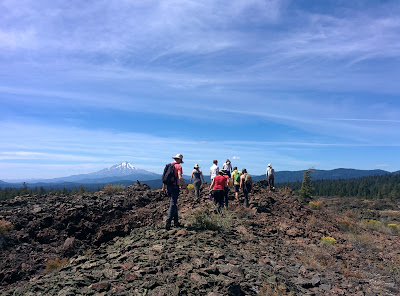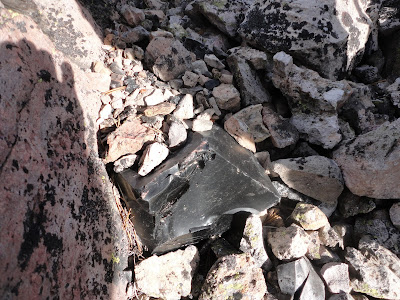So, a lot of descriptions of rocks are pretty bland but rocks are actually really sweet! In fact, rocks do a lot of things that can be recreated with sugar.
The following are the sugar analogs of geologic features:
Lava tubes: super long roasted marshmallows
Aa lava: spattered melted marshmallow
Pahoehoe lava: frosting
Pumice: cotton candyObsidian: squashed cotton candy
 |
| Collapsed lava tube |
This collapsed lava tube is similar to the outer shell of a roasted marshmallow with a melted inside, but the interior of this tube is sent through in pulses, leaving different layers that are identifiable by composition and superposition. When the melted inside is gone, the lava tube often collapses, providing openings for cavers to explore.
 |
| Scaly plates near Chimney crater |
Imagine that a small volcano is a pot of boiling melted marshmallows. A lot of drops will splash up over the side and splatter in flat scales around the pot. Now imagine that when the pot is near empty, new marshmallows are added. This picture shows an area near a small crater that had bursts of activity, including lava tubes and this spattering process.
This lava is called aa because that's the sound you make if you step on it barefoot. It is sharp, with holes like swiss cheese (we call them vesicles) and is similar to what would result if you threw melted marshmallows at a pan and then froze them.

Giant Crater, with a lava tube exit on the far side in the middle.
Giant crater is a very impressive sight and worked with mechanisms similar to Chimney Crater.
 |
| Pahoehoe lava, likely chilled while erupting |
This is Tim's favorite spot. It's the only pahoehoe lava in the area and he thinks that it was formed when there was a snow storm at the same time as an eruption from Giant Crater. It looks similar to piped icing on the surface but becomes vesicular less than 1 cm from the surface (see the upper right part of the photo).

Glass Mountain
Glass mountain is a huge mass of obsidian and pumice with evidence of magma mixing at all scales. If you're not sure what pumice is, it was probably used to exfoliate your feet at the spa. Glass mountain has been mined for pumice several times as different products have gone in and out of use. Obsidian is so sharp that we can't make anything sharper so we use it for surgical scalpels.
I prefer to think of these rocks as cotton candy and squished cotton candy. They have the same composition and all started out with vesicles but the obsidian got rid of their bubbles. In the same way that cotton candy changes color when compressed, obsidian is much darker than pumice.
I'll let the rest of the pictures speak for themselves.
|
| Obsidian next to pumice |
 |
| Statuesque obsidian chunk |
 |
| Pink rocks are remnants of magma mixing |
 |
| Color changes with concentration of vesicles (holes) |
 |
| "Jig-saw" obsidian |
 |
| Large vesicles vs. small vesicles |
 |
| Yes, it's that big. |
 |
| Blob of obsidian |
 |
Obsidian vs. pumice with brass rat for scale
So I hope that you now see that rocks are sweet, and not just to geologists. We saw these things on 8/27/15 in Northern California. |













